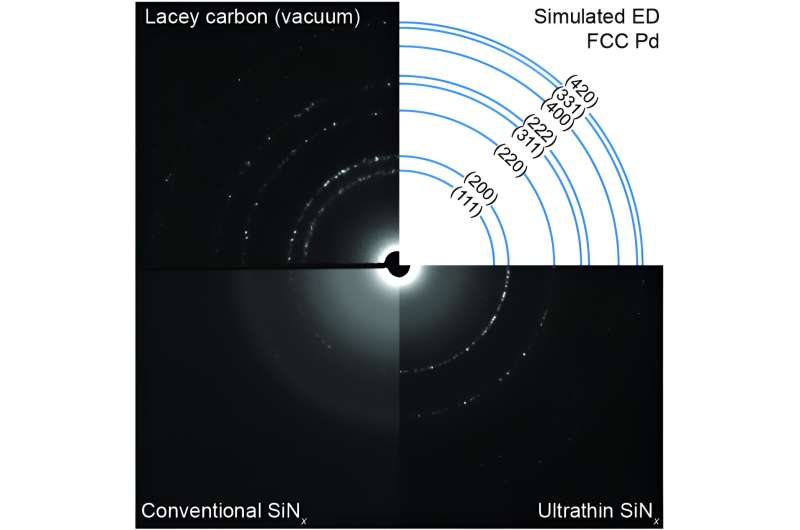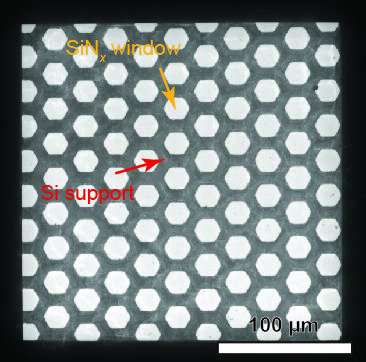January 30, 2024 dialog
This article has been reviewed according to Science X's editorial process and policies. Editors have highlighted the following attributes while ensuring the content's credibility:
fact-checked
peer-reviewed publication
trusted source
written by researcher(s)
proofread
Ultrathin membranes for uncovering the atomic scale problem in operando conditions

When someone comes up with the word "magnify," it is referring either to making distant objects closer or making small objects bigger on a tangible scale. There is no doubt that the power of magnifying instruments, regardless of the scale and direction, can lead to the advancement of the scientific field. Since its launch in 2021, James Webb Space Telescope (JWST) has embarked on a mission to collect unprecedented data from the deep universe, aiming to extend our understanding of the early universe and lifecycle of celestial bodies.
The apt analogy for the JWST in the atomic world is the Aberration-Corrected Electron Microscope (ACEM). By harnessing a highly coherent electron along with an aberration corrector, the microscope excels in resolving subatomic features, allowing for a comprehensive exploration of the structure-functional relationship in materials. As a staple for nano-world navigators, the modern ACEM can provide invaluable information that remains irreplaceable by other characterization methods.
The contradiction arises from the dual nature of the high energy electrons. The wave property of the electron allows for high-resolution imaging, while their particle property makes collisions inevitable. As the particle travels through the ambient pressure gas, their mean free path—the distance they can travel before substantially changing their original direction or energy—is only limited to approximately 100 nm.
Ballistic collisions alter the electron's direction or deplete its energy, significantly hindering the performance of the electron optics. To circumvent these collisions, the microscope column is usually maintained under ultra-high vacuum conditions, which are at least 1010 times thinner than ambient air.
The nature of the ACEM restricts its applicability to static, thin, and solid samples. However, materials encompass various states of matter beyond solids, including liquids, gases, and plasmas. To observe reactions at the nanoscale, it is essential to encapsulate the involved fluidic media within a sealed nanoreactor, preventing their dissipation. The utilization of the silicon nitride micro-electro-mechanical systems (MEMS) technique addresses these special needs, enabling researchers to explore reactions at the nanoscale.

The silicon nitride film, serving as an encapsulation membrane, can be conveniently produced with a thickness in the range of a few tens of nanometers using chemical vapor deposition process. These films exhibit reasonable resilience to mechanical shock, particularly when they have more than a certain thickness, although there is a trade-off relationship with electron transparency.
Analogous to an aquarium with glass wall that is several feet thick, which may be robust enough to contain large amount of water, maximizing visibility through the glass becomes challenging. Therefore, engineering the "wall" is crucial for ensuring optimum visibility in both aquariums and the fluid container for ACEM.
To address this challenge, we draw inspiration from the beehive, a structure that withstands high mechanical stress while using minimal material. Our solution involves creating a space-filling hexagonal support system using heavily doped silicon beneath the ultrathin silicon nitride, achieving this with only 1/5th of the thickness to conventional method.
The beehive-like structure maximizes opening for observing the reactions and provides optimal strength under mechanical stress. Through this ultrathin breakthrough, the membrane can be thinned down to a single-digit nanometer scale—approximately 1/10,000th of the thickness of a human hair, without experiencing rupture or leaks in the microscope.
The transparency of the ultrathin membrane allows for the mapping of fluids with sub-nanometer spatial resolution and significant suppression of the adverse electron scattering, a capability not achievable with conventional enveloping materials. This breakthrough enables sensitivity in the gas phase to the extent of detecting a handful of gas molecules inside the transmission electron microscope (TEM). This level of sensitivity permits capturing reactions occurring at the gas-solid interface with microsecond-scale time resolution.
As an illustrative example, we visualize the insertion of hydrogen atoms into palladium metal under ambient temperature and pressure conditions. This technology holds immense potential for developing and investigating nanocatalysts for gas-phase carbon capture, as well as for energy materials such as fuel cells and metal-air batteries, providing atomic scale insights. Our work is published in the journal Science Advances.
Although operating at a different scale and scope, we draw a parallel between this development and the groundbreaking capabilities of the James Webb Space Telescope (JWST), which is delivering unprecedented images and data challenging cosmological theories. Furthermore, we propose that this innovative strategy for designing microchips with ultrathin membranes can be extended to various applications where the thin membranes serve as encapsulations and/or support materials, with implications extending beyond the field of nanoscience.
This story is part of Science X Dialog, where researchers can report findings from their published research articles. Visit this page for information about ScienceX Dialog and how to participate.
More information: Kunmo Koo et al, Ultrathin silicon nitride microchip for in situ/operando microscopy with high spatial resolution and spectral visibility, Science Advances (2024). DOI: 10.1126/sciadv.adj6417
Journal information: Science Advances
Dr. Kunmo Koo is a research associate in the NUANCE Center. Dr. Xiaobing Hu is a research associate professor at the department of materials science and engineering and TEM Facility Manager at NUANCE center. Dr. Vinayak P. Dravid is the Abraham Harris Professor of Materials Science and Engineering and founding director of the NUANCE Center.




















